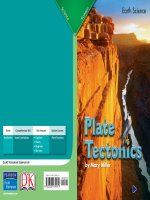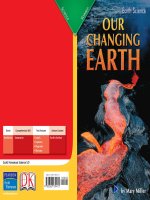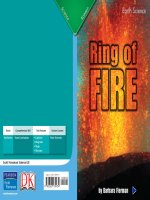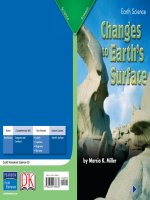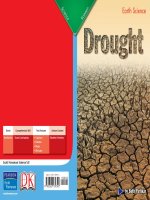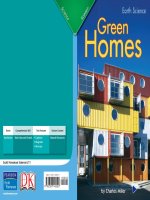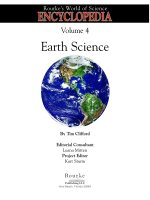4 10 wind power (earth science)
Bạn đang xem bản rút gọn của tài liệu. Xem và tải ngay bản đầy đủ của tài liệu tại đây (3.13 MB, 10 trang )
Genre
Nonfiction
Comprehension Skill
Cause and Effect
Text Features
•
•
•
•
Captions
Text Boxes
Call Outs
Glossary
Science Content
Natural Resources
Scott Foresman Science 4.10
ISBN 0-328-13888-6
ì<(sk$m)=bdi id< +^-Ä-U-Ä-U
Vocabulary
Extended Vocabulary
conservation
fossil fuels
humus
ore
petroleum
recycling
solar cells
solar energy
efficiency
gearwheel
power plants
prevailing winds
rig
turbine
wind farm
Picture Credits
Every effort has been made to secure permission and provide appropriate credit for photographic material.
The publisher deeply regrets any omission and pledges to correct errors called to its attention in subsequent editions.
Photo locators denoted as follows: Top (T), Center (C), Bottom (B), Left (L), Right (R), Background (Bkgd).
Opener: Jorgen Schytte/Peter Arnold, Inc.; 7 Reuters/Corbis; 9 Science Museum, London/DK Images;
11 (T) Science Museum, London/DK Images; 14 Jorgen Schytte/Peter Arnold, Inc.
Unless otherwise acknowledged, all photographs are the copyright © of Dorling Kindersley, a division of Pearson.
ISBN: 0-328-13888-6
Copyright © Pearson Education, Inc. All Rights Reserved. Printed in the United States of America.
This publication is protected by Copyright, and permission should be obtained from the publisher prior to any
prohibited reproduction, storage in a retrieval system, or transmission in any form by any means, electronic,
mechanical, photocopying, recording, or likewise. For information regarding permission(s), write to
Permissions Department, Scott Foresman, 1900 East Lake Avenue, Glenview, Illinois 60025.
3 4 5 6 7 8 9 10 V010 13 12 11 10 09 08 07 06 05
What did you learn?
1. How can wind be used to produce
electricity?
2. What causes wind?
3. What were windmills used for long ago?
by C. A. Barnhart
4.
Triangular sails catch
the wind better than square sails do.
Write to explain why triangular sails are
more efficient. Use examples from the
book to support your answer.
5.
Cause and Effect What are some of
the effects of burning fossil fuels for
power?
What You Already Know
People, animals, and plants all need natural
resources to live. Some natural resources are replaced
all the time. Although renewable natural resources are
in abundant supply, they must be well cared for. Soil
is one important renewable resource. Soil is renewed
through weathering, erosion, and deposition. Soil
contains humus. Humus is made from decaying plant
and animal matter. Clay, silt, and sand are kinds of
soil that have different properties. Good farming can
replace nutrients in soil. Many things can be made
from soil.
Solar energy is another
renewable resource. Electricity
can be produced from solar
energy by collecting the
Sun’s energy with solar
cells. Electricity can
also be produced by
using energy from
moving water.
Plowing the remains
of plants into the field
returns nutrients to
the soil.
2
Other resources that we
rely upon, including fossil
fuels such as natural gas,
coal, and petroleum, are not
easily or quickly replaced.
An ore is a mineral-rich rock
found in Earth’s crust.
Many nonrenewable mineral
resources are found in ores.
wind farm
All natural resources are
important and must be used
wisely. Production of energy is a major use of fossil fuel.
Electricity and gasoline keep our factories operating, our
houses warm, and our transportation moving.
There are several ways to practice conservation of our
natural resources and still produce the power we need.
One way is by recycling. Recycling reduces the amount of
nonrenewable resources we use. Some paper and plastics
are recyclable. Another way is to increase the use of
renewable resources to produce power.
Wind is another natural source of renewable energy.
People have used the power of the wind for centuries.
Today, we are using it more and more. Read on to find
out about wind power.
3
Global Winds
The Power of Wind
In order to learn how wind can be used as a source
of power, first you must understand what wind is.
Wind is caused by differences in temperature
in Earth’s atmosphere. Air flows
constantly over Earth. Pockets of air
rise from Earth’s surface as they
become warmer and their
molecules become less dense.
Cool air, which has more densely packed
molecules, rushes in to take the place of the
warm air. This movement of cold, heavy air falling
and warm, lighter air rising is called wind.
Wind can have a powerful effect on landforms,
or features of Earth’s surface. Wind can cause
erosion, changing the shape of rock formations.
Blowing wind changes
the shapes of rocks
by erosion.
4
easterlies
A toy pinwheel
demonstrates
how wind power
turns a wheel.
westerlies
trade winds
doldrums
trade winds
westerlies
easterlies
Easterlies are winds that
blow from east to west.
Westerlies are winds that
blow from west to east.
Trade winds are found
above and below the
equator and blow almost
constantly. Few winds
blow in the doldrums.
Earth’s prevailing
winds form at the equator
where the air is hot and
rises high into the
atmosphere. Little wind
results. On each side of
the equator, however, a
band of brisk winds blows
toward it. These winds are drawn toward the equator by
the heated air moving upward. Winds farther north and
farther south are also affected by the hot air from the
equator when they meet cold air from the North and
South Poles.
Although you can’t see wind, it is a very powerful
force. The spinning motion of this toy pinwheel is
physical evidence of the wind’s effect.
5
Wind for Movement
Until the 1900s, the main power for ships was
the wind. Today, sailing ships are used mostly for
education and sport.
A sailboat today is not very different from ships of
ancient times. All are moved by the wind. All have sails
controlled by ropes.
A newer and portable sailboat is the sailboard. It
is a surfboard with a sail. The rider sails or windsurfs
while standing up and steers by pulling in and letting
out the sail. Sailboards tip easily.
Sailboats and sailboards used
for sport have triangular sails
to catch the wind.
6
The ancient Egyptians were
probably the first people to use
the wind to move boats. They
are credited with developing
cloth sails around 3300 B.C. The
first sails were square. Square
sails worked well when the wind
came from behind the boat. The
wind would then fill the sail and
move the boat forward. If the
wind came from the wrong
direction, however, the only way
to move a boat with a square sail
was by rowing.
About two thousand years
Clipper ships have
ago, ships traveling on the
many sails that can
Mediterranean Sea began using
catch the wind.
triangular sails. The sail was
fixed to a pole called a mast. Ropes were used to move
the sail from one side to another. The sail could catch
the wind from any direction. Later, ships were rigged
with a combination of square and triangular sails. Many
sails meant more power and speed from the wind. Ships
could be larger. A clipper ship is an example of a ship
with such rigging.
7
Gliders, hang gliders, and
balloons move through the air
glider
and return to Earth’s surface
using only wind power. Gliders fly along wind
currents after being towed into the air by a plane or
after catching the wind on a hillside or cliff. Hang
gliders catch the wind in the same way. Weather
balloons are carried by winds to make weather
observations. A kite catches the wind in its sails and
soars through the air. All these ways of flying use the
wind not only to go higher, farther, and faster, but also
to steer and to land.
A kite is released into the
air. You can guide it with
a string while the wind
carries it.
Wind for Machines
People have used wind power to operate machines
for centuries. Wind is turned into power for machines
in a way similar to the way a paper pinwheel works.
A wheel catches the wind and turns, changing the power
of the wind into a power that works machinery.
In the United States, windmills were used on
farms in the 1800s to pump water from wells deep
underground. These windmills had a wheel that could
turn in any direction to face the wind. The wheel was
guided by a vane at the other end of a horizontal pole.
This horizontal pole transferred power to a vertical pole.
This power operated a pump underground.
steering vane
blades
pole takes power
to water pump
8
The metal American
windmill made it possible
for farmers in dry regions
to pump water for their
animals and crops.
9
Windmills
It is thought that the first windmills were built in
what is now Iran, about fourteen hundred years ago.
These early windmills had a wheel with sails that turned
as they caught the wind. The wheel was fastened to the
top of a pole. The wheel turned this pole. These early
windmills were used mostly to grind grain.
Since the wheel of this early windmill was fastened
to the top of the pole, the wind had to blow directly on
the sails from a particular direction. This meant the
windmills were quite inefficient.
By about 1100, windmills appeared in Europe,
especially in what is now the Netherlands. There they
were used mostly to pump water away from land that
was often flooded by the sea. In these Dutch windmills,
the wheel or sails were attached to a horizontal pole.
People used gears and pulleys to transfer the power from
the horizontal pole to a vertical pole.
A windmill such as
this was used to grind
grain. This model
shows the gearwheel,
which changed the
direction of power
from horizontal
to vertical. The
grindstone was used
for grinding the grain.
gearwheel
grindstone
This vertical pole worked the pump that was located
at the bottom of the windmill. Later windmills had
wheels that could be turned in any direction to face the
wind. This marked a great improvement in their
efficiency. These new windmills could use the wind no
matter which way it was blowing.
These windmills in
La Mancha, Spain, were
used for grinding grain.
10
11
Wind for Electricity
Most electricity in the United States is produced in
power plants that burn fossil fuels or use nuclear power
or water power. There is a limited supply of fossil fuels.
When fossil fuels are burned, pollutants are released
into the environment. Nuclear waste from nuclear
power plants is difficult and expensive to dispose of.
One solution to these problems is to produce
electricity by using the wind. It is an abundant,
renewable resource, which makes it an appealing source
of power. Wind is also appealing because it doesn’t
cause pollution.
Electricity produced by wind is generated in a wind
turbine. This is a kind of modern windmill designed
especially to make electricity. The wind turbine has
three huge blades at the top of a tall tower. These blades
are turned by the wind. Similar to the Dutch and
American windmills, the blades are attached to a
horizontal pole. The pole turns a wheel directly behind
the blades. The turbine generates electricity that is then
sent over power wires. Groups of wind turbines built
in one place are called wind farms.
Fossil Fuels
Smoke rising from a
power plant that burns
fossil fuels spreads
through the air and
pollutes the environment.
A wind farm such as this one
contains many wind turbines.
12
13
The turbines that generate electricity are designed
to increase the amount of power made by the rotating
blades. By increasing their power, turbines are able to
produce greater amounts of electricity.
A wind farm must be located where there are steady
winds. Some wind farms can produce enough electricity
for a small town. Some farmers have put up a few wind
turbines to produce just enough electricity to meet their
own needs. Some large electric companies have begun to
build very large wind farms.
Another location for wind farms is in the ocean,
along a coastline. The winds are steadier over the water.
They can produce electricity more efficiently.
Some people object to wind turbines claiming they
are noisy. However, most of the turbines are no noisier
than leaves rustling in a breeze. Another reason people
may object is that they feel that wind turbines are not
very nice-looking. But perhaps the benefits of using
them, such as less air pollution, will make them seem
more attractive.
All countries of the world need more electricity.
At the same time, pollution is becoming more of
a problem. Use of the world’s winds to generate
electricity makes wind farms an increasingly appealing
way to get the electricity we need without harming
the environment.
Offshore wind farms are built in
coastal waters, where they take
advantage of steady winds.
14
15
Vocabulary
Glossary
conservation
fossil
fuels
effi
ciency
humus
ore
petroleum
gearwheel
recycling
solar cells
solar energy
power
plants
Extended Vocabulary
efficiency
gearwheel
production
of something with
power
plants
little waste of time
or effort
prevailing winds
rig grooves that fit
a wheel with
turbine
into another
gear
wind farm
stations that generate power,
often by burning fossil fuels
What did you learn?
1. How can wind be used to produce
electricity?
2. What causes wind?
3. What were windmills used for long ago?
4.
Triangular sails catch
the wind better than square sails do.
Write to explain why triangular sails are
more efficient. Use examples from the
book to support your answer.
5.
Cause and Effect What are some of
the effects of burning fossil fuels for
power?
prevailing winds winds that are most common,
especially in terms of reliability,
force, or direction
rig
to fit a boat or ship with equipment,
such as a sail, mast, and ropes
turbine
a machine that has a rotating wheel
with paddles attached to it that spin
Picture Credits
Every effort has been made to secure permission and provide appropriate credit for photographic material.
as the wheel turns
The publisher deeply regrets any omission and pledges to correct errors called to its attention in subsequent editions.
Photo locators denoted as follows: Top (T), Center (C), Bottom (B), Left (L), Right (R), Background (Bkgd).
wind farm
a cluster of wind turbines built near
each are
other
to generate
electricity
Unless otherwise acknowledged, all photographs
the copyright
© of Dorling Kindersley,
a division of Pearson.
Opener: Jorgen Schytte/Peter Arnold, Inc.; 7 Reuters/Corbis; 9 Science Museum, London/DK Images;
11 (T) Science Museum, London/DK Images; 14 Jorgen Schytte/Peter Arnold, Inc.
ISBN: 0-328-13888-6
Copyright © Pearson Education, Inc. All Rights Reserved. Printed in the United States of America.
This publication is protected by Copyright, and permission should be obtained from the publisher prior to any
prohibited reproduction, storage in a retrieval system, or transmission in any form by any means, electronic,
mechanical, photocopying, recording, or likewise. For information regarding permission(s), write to
Permissions Department, Scott Foresman, 1900 East Lake Avenue, Glenview, Illinois 60025.
3 4 5 6 7 8 9 10 V010 13 12 11 10 09 08 07 06 05
16

